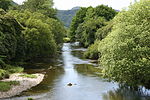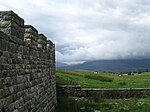The Festiniog & Blaenau Railway (F&BR) was a narrow gauge railway built in 1868 to connect the town of Blaenau Ffestiniog in Wales with the slate quarries around Tanymanod and the village of Llan Ffestiniog, 3+1⁄2 miles (5.6 km) to the south. At Blaenau Ffestiniog it made a direct connection with the Festiniog Railway (FR) with which it was closely associated during its fifteen-year life. The railway was purchased by the Bala and Festiniog Railway in 1883 and converted to 4 ft 8+1⁄2 in (1,435 mm) standard gauge to extend the Bala Ffestiniog line, a branch of the GWR's line from Ruabon to Barmouth.
The promoters owned the land on which the line was built, so no parliamentary process was needed to incorporate the company or proceed with building, though the operators sought and obtained Board of Trade inspection before opening as if that were a statutory requirement.Officially the line's gauge was 1 ft 11+3⁄4 in (603 mm), however, a Board of Trade inspection in 1868 recorded it as 1 ft 11+1⁄4 in (591 mm), as did the locomotives' manufacturer's catalogue, repeated in the magazine "Engineer". A survey of the line conducted by Vignes in 1878 gave the gauge as 1 ft 11+1⁄2 in (597 mm). In practice the tolerances were sufficiently wide to allow Festiniog Railway locomotives and rolling stock to use the line, but there is no record of F&BR stock venturing onto FR metals other than transit to Minffordd when their two locomotives made rare visits to Wolverhampton for heavy repair. They are unlikely to have made these trips along the FR in steam and may even have travelled on flat wagons.








